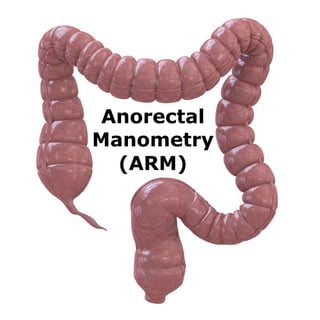
Anorectal manometry is a widely-available, economical and precise test for establishing the functional competency of the rectum and the anal canal. It plays an essential role in the diagnosis of functional defecatory disorders such as constipation, fecal incontinence and Hirschsprung disease in children.
This test involves the assessment of two major functions of the anorectal system. The resistive system – continence; and the capacitive system – defecation. Continence and defecation are the two most important roles played by the anorectal system. Quantitative assessment of the anal sphincter tone by anorectal manometry helps find the etiology of anorectal disorders. In the following article, we are going to discuss briefly how to interpret conventional anorectal manometry.
Patient Preparation
Patients should receive an explanation how the procedure works and be put in a semi-recumbent position as the parameters below are assessed. We shall focus on the interpretation of anorectal manometry which can assess:
- Rectoanal reflex activity
- Rectal sensation
- Anal sphincter tone
- Rectal compliance
- Changes in rectal and pressures during attempted defecation
- As a part of anorectal manometry, two additional tests will also be done: An anal sphincter electromyography (EMG), a test to evaluate the nerve supply to the anal muscle, and
- Balloon expulsion test, the measurement of the time taken to expel a filled balloon.
Anal Sphincter Function
Anal sphincter funtion is assessed by:
- Resting sphincter pressure - measures the internal anal sphincter pressure. It is the pressure difference between intrathecal pressure and the highest recorded pressure in the anal sphincter at rest, recorded generally 1-3 cm from the anal verge.
- Squeeze sphincter pressure - measures the external anal sphincter pressure. It is the pressure difference between the highest pressure recorded at any point within the anal canal and the intrarectal pressure during the squeeze maneuver.
- Functional length of the anal canal – It is the length of the anal canal whose pressure is more than half of maximum resting pressure.
Rectoanal Reflex Activity
There is a temporary elevation in the rectal pressure during rapid distention of the recutm. This induces an increase in the anal pressure and contraction of the External Anal sphincter which maintains the continence. This is called the recto-anal contractile reflex. It is followed by a more prolonged reduction in anal pressure due to the relaxation during the rectoanal inhibitory reflex; that is, the relaxation of internal anal sphincter, leading to prolonged decrease in the anal pressure.
Usually, when there is a sudden but transient increase in the intra-abdominal pressure such as coughing, there is a sudden increase in the rectum and the anal canal. Due to the contraction of the external anal sphincter at this stage by the rectoanal contractile reflex, there is maintenance of continence. In patients with fecal incontinence, anal sphincter pressures do not show an increase during increased intra-abdominal pressure such as valsalva or coughing. Normally, the reflex should occur when 10-30mL of air is infused into the rectum.
Rectal Sensation
With the patient in a semi-recumbent position, a quantity of air is infused and recorded at three different points of time.
- Till it evokes a sensation of rectal filling, normally 10-60 mL
- A desire to defecate, normally 10-100 mL
- The maximum tolerable rectal volume, normally 200-300 mL
This assessment aids in the diagnosis of fecal incontinence due to neuromuscular abnormality.
Changes in anal and rectal pressures during attempted defecation
During defecation, the normal physiological response is an increase in the rectal pressure with consequent relaxation of the external anal sphincter. In obstructive defecation, which is the most common cause of constipation, there is an inability to perform this maneuver. Anorectal manometry can quantify this response with the defecation Index (DI).
Normally, DI is around 1.5.
Three major types of obstructive defecation are seen in patients:
- During attempted defecation with a normal pushing force there is a paradoxical increase in the anal sphincter pressure
- Some patients have an inability to render enough pushing force and exhibit a quick anal contraction
- Patients are able to render adequate pushing force but fail to achieve adequate sphincter relaxation.
Rectal Compliance
Rectal compliance is the ability of the rectum to distend. It is calculated by plotting a graph with the balloon volume and a steady state intrarectal pressure. Compliance is inversely proportional to resistance to distention.
Anal Sphincter Electromyography
Small electrodes are placed perianally and the muscle’s electrical activity received is recorded. It confirms proper muscular contractions during the act of defecation and continence. In patients with paradoxical contraction of sphincter and pelvic floor muscles, there is an increased electrical activity instead of a normal decrease during the efforts of defecation. Normal anal EMG with low anal squeeze pressures indicates surgically repairable torn sphincter.
Balloon Expulsion Test
This test is to assess the rectoanal coordination maneuver during defecation. In this test a filled balloon is inserted into the rectum and the patient is asked to expel the same through defecation. This is a simple and physiologic appraisal of defecation dynamics. Normally, the balloon is expelled in one minute. More than three minutes indicate obstructive defecation in the patient.
Conclusion
Conventional anorectal manometry is a useful diagnostic procedure that estimates contractility of anus and the rectum that aids in the diagnosis of functional anorectal disorders. The anorectal manometry indicates the prognosis of treatment, particularly in the management of certain sphincter injuries and may be used in biofeedback treatment of anismus and solitary rectal ulcer syndrome. The appropriate interpretation and a thorough clinical correlation of these tests are of paramount importance.
If you need help adding anorectal manometry to your practice or hospital, click the button below. We help many dozens of practices and hospitals successfully implement anorectal manometry.


